This one is controversial anyway read on...I have consumed bracket rhizome starch in the past with no I'll effects but it's controversial ,the Pacific northwest
People's of America the tlingit Indians ect cooked bracken rhizomes in big pits for hours then they p ounded the rhizomes with stones rolled the starchy gloop into balls and baked a form of bread also bracket term flour is widely consumed in Japan , her es were the controversy lies it's apparently carcinogenic but the studies were only done on animals and that's when it's unprocessed raw , ptaquiloside the toxin carcinogen varies greatly from plant to plant some it's zero some it's high it's totally random ,also cooking removes it, leaching and I seen a chef on tv soak bracken fronds in water and ash and serve it to customers, iv done lots of ethnobotanical research on this and some sides argue its 100% safe some argue it isn't ,I personally tried it for the purposes of science with no Ill effects if anyone else has experience with this interesting plant let me know thanks
People's of America the tlingit Indians ect cooked bracken rhizomes in big pits for hours then they p ounded the rhizomes with stones rolled the starchy gloop into balls and baked a form of bread also bracket term flour is widely consumed in Japan , her es were the controversy lies it's apparently carcinogenic but the studies were only done on animals and that's when it's unprocessed raw , ptaquiloside the toxin carcinogen varies greatly from plant to plant some it's zero some it's high it's totally random ,also cooking removes it, leaching and I seen a chef on tv soak bracken fronds in water and ash and serve it to customers, iv done lots of ethnobotanical research on this and some sides argue its 100% safe some argue it isn't ,I personally tried it for the purposes of science with no Ill effects if anyone else has experience with this interesting plant let me know thanks

 )
)
